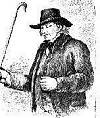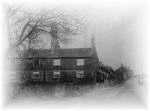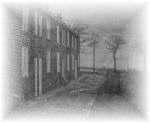|
Mount Pleasant Village is an isolated and important
example of a "factory" village, and illustrates an important
aspect of early industrial growth in the Upper Pennine area. The
village is situated on the exposed shoulder of Snape Hill below
Harden Moor, 2 miles north of Bury and 1 mile north of the village
of Walmersley on Walmersley Old Road. Walmersley Old Road was once
the turnpike road from Bury to Burnley with the tollhouse being
at Walmersley post office.
 In
1790 the road was improved by the famous road builder John Metcalf
of Knaresborough who was known as "Blind Jack"
due to him losing his sight as a child from smallpox. A wax effigy
of him can be seen in the museum of Knaresborough together with
a plaque, which states that he was a smuggler before he became a
road builder. Click
here to find out more. In
1790 the road was improved by the famous road builder John Metcalf
of Knaresborough who was known as "Blind Jack"
due to him losing his sight as a child from smallpox. A wax effigy
of him can be seen in the museum of Knaresborough together with
a plaque, which states that he was a smuggler before he became a
road builder. Click
here to find out more.
The area of Nangreaves acquired its name from Richard
Nangreaves who had an estate there as well as owning surrounding
properties such as Higher Sedger Hey, Top of the Hough, Bent House
and Gollinrod. The Nangreaves family was important in Lancashire
in the 18th century and owned estates in Lancashire, Chester and
Stafford. Richard Nangreaves died in 1800. He had a brother Samuel
Wareing Nangreaves who was a Lieutenant-Colonel in the British army
and who is buried in the Abbey Church in Bath.
The name of Nangreaves is pure Saxon and is probably derived from
the goat breeding that was an important part of farming. The 'greve'
refers to the chief goatherd and the 'nan' to the female
goat (the nanny goat). Thus it is very similar to the surname 'Shepherd'
which refers to sheep farming. Farmers said of the area of Nangreaves
"If you can farm up there you can farm anywhere".
 The
house where Richard Nangreaves lived had a tree lined drive leading
up to it through an archway formed from the jaw bone of a whale
resting on two pillars. Unfortunately the house was demolished many
years ago but old maps show it to have been near the area of the
present bus turnaround, and the stables can still be seen forming
part of the gatehouse to the south end of the village. The
house where Richard Nangreaves lived had a tree lined drive leading
up to it through an archway formed from the jaw bone of a whale
resting on two pillars. Unfortunately the house was demolished many
years ago but old maps show it to have been near the area of the
present bus turnaround, and the stables can still be seen forming
part of the gatehouse to the south end of the village.
The history of the present settlement dates from early in the 19th
century. The village of Nangreaves was sold to John Hall and his
two brothers in 1819. These 3 brothers had established a mill at
Gorsey Brow in Bury in 1803 and started up with over 100 handloom
weavers who worked mainly from home. John Hall was born in 1780
on 12th December and died on 13th September 1870.. His memorial
tablet can be found in the West Wall of the choir vestry at Walmersley
Church and the beautiful stained glass window was given in his memory
by his workpeople. Many generations of families worked for John
Hall, and many individuals worked in his mill at Mount Pleasant
for up to 50 or 60 years. His employees considered John Hall to
be a good employer who worked as hard or harder than those he employed.
When he died in 1870 at the age of 90, the business passed to John
(Jack) Hall of Baldingstone.
 John
Hall established a mill at Mount Pleasant in 1820 by moving his
business from the Gorsey Brow site. At first the business acted
as a collecting point for the cottage weaving industry, and weavers
from Holcombe, Tottington, Affetside, Bradshaw, Harwood and Bolton
would bring their cloth to Nangreaves and would return home with
the warp and weft. At this time the business employed well over
1,000 weavers. Many of his weavers worked from their cottages, but
the coming of the steam age and the power loom put an end to the
cottage industry. John
Hall established a mill at Mount Pleasant in 1820 by moving his
business from the Gorsey Brow site. At first the business acted
as a collecting point for the cottage weaving industry, and weavers
from Holcombe, Tottington, Affetside, Bradshaw, Harwood and Bolton
would bring their cloth to Nangreaves and would return home with
the warp and weft. At this time the business employed well over
1,000 weavers. Many of his weavers worked from their cottages, but
the coming of the steam age and the power loom put an end to the
cottage industry.
John Hall began building a new mill, incorporating weaving sheds,
power looms and later a spinning shed, and applied himself to improving
methods of producing quilting cloth for which he was well known.
As the prosperity of the business increased, further additions were
made to the mill building, and terraced cottages were built around
the mill to provide homes for the spinners and weavers. The earliest
terrace cottages date from 1819, and were part of the mill building
immediately adjoining Walmersley Old Road. Other terraces are later
but are pre-1851, while the two terraces to the extreme west (the
lower village) are post-1850, and numbers 1 to 6 were built in 1903 .
(It appears from looking at the area that these numbers may have
been taken from the earlier 1819 terraces). The Lord Raglan pub
dates from 1825. (the fact that the Raglan is still flourishing
proves, it seems, that the demand for beer is greater than the demand
for textiles). The mill was one of the earliest to be illuminated
by electric light in 1888. The last alterations to the mill were
made in 1893 with the addition to the weaving shed, while the last
workers' houses were built in 1903. .
(It appears from looking at the area that these numbers may have
been taken from the earlier 1819 terraces). The Lord Raglan pub
dates from 1825. (the fact that the Raglan is still flourishing
proves, it seems, that the demand for beer is greater than the demand
for textiles). The mill was one of the earliest to be illuminated
by electric light in 1888. The last alterations to the mill were
made in 1893 with the addition to the weaving shed, while the last
workers' houses were built in 1903.
 Nangreaves
had its own football team which played matches from the turn of
the century until the great war. The village also had its own co-operative
shop which operated from No.14 Mount Pleasant from 1880 until it
closed in 1906. In the quarter ended June 8th 1901 the profit was
£37, which meant that every one of its 45 members received
3s (three shillings) dividend with £1 2s 11d left to be carried
over to the next quarter. Wages for the shopkeeper were £13
per quarter, carriage charges 10s per quarter, coal for heating
the shop 2s. For all you youngsters, one shilling is the equivalent
of 5p today and there were 12d (twelve pennies) in a shilling. The
maths is now up to you! Nangreaves
had its own football team which played matches from the turn of
the century until the great war. The village also had its own co-operative
shop which operated from No.14 Mount Pleasant from 1880 until it
closed in 1906. In the quarter ended June 8th 1901 the profit was
£37, which meant that every one of its 45 members received
3s (three shillings) dividend with £1 2s 11d left to be carried
over to the next quarter. Wages for the shopkeeper were £13
per quarter, carriage charges 10s per quarter, coal for heating
the shop 2s. For all you youngsters, one shilling is the equivalent
of 5p today and there were 12d (twelve pennies) in a shilling. The
maths is now up to you!
 The
mill produced the waistcoat and shirt front materials which were
worn by Fred Astaire and the rest of the cast in the film 'Top Hat'
in 1935. In fact the mill was nicknamed Top Hat Mill. It
was also the only place to make the white material which covered
naval officers' caps. The
mill produced the waistcoat and shirt front materials which were
worn by Fred Astaire and the rest of the cast in the film 'Top Hat'
in 1935. In fact the mill was nicknamed Top Hat Mill. It
was also the only place to make the white material which covered
naval officers' caps.
Early in the second world war the mill was closed along with other
mills but was allowed to open some 12 months later on account of
the exceptional clothes that it made. The business which had started
selling goods in Manchester had now expanded into London and home
markets as well as abroad.
With the decline in the cotton industry the mill was forced to
close after 150 years in November 1965 (the manager at the time
was Mr Bernard Lilley). The mill was later sold and used for the
production of plastics until it was closed for the final time in
1983.
The village became a conservation area in 1974, and the cottages
are Grade II listed buildings. It was one of the few surviving examples
of the "factory village" in Greater Manchester.
 The
mill was finally closed in 1983 and in the late 80's the now neglected
mill suffered a fire so severe that it was finally demolished The
stones from the mill buildings were re-faced and used to build new
houses on the site of the once famous mill. Alas, this meant the
end of the mill chimney, which was a local landmark, and the filling
in of the lodge to become a village green. Village residents turned
out with buckets and bowls to help rescue fish and other wildlife
from the lodge before it was filled in. The
mill was finally closed in 1983 and in the late 80's the now neglected
mill suffered a fire so severe that it was finally demolished The
stones from the mill buildings were re-faced and used to build new
houses on the site of the once famous mill. Alas, this meant the
end of the mill chimney, which was a local landmark, and the filling
in of the lodge to become a village green. Village residents turned
out with buckets and bowls to help rescue fish and other wildlife
from the lodge before it was filled in.
Some further interesting details about Nangreaves are that in 1962
drill tests were done for oil, which was found but not in amounts
economical to extract. A bus service first ran to the village in
1950 and operated 3 days a week. The first residents to use the
bus were Mrs Mary Alice Haworth from No.4, Mrs C Mills from No.26,
George Newby from No.2 and Mrs M H Graham, the 80 year old mother
of the licensee of the Lord Raglan pub.
|

